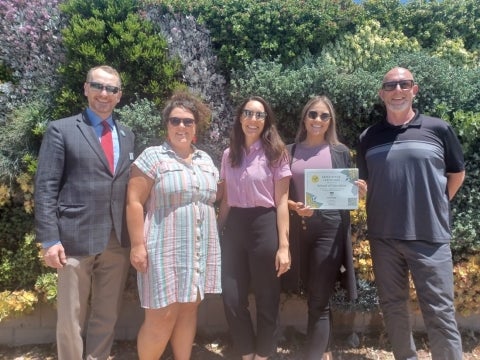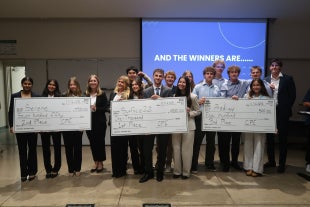Cal Poly Launches Green Office Certification
Contact: Kylee Singh
805-756-5397; klsingh@calpoly.edu
SAN LUIS OBISPO – Cal Poly recently launched a Green Office Certification (GOC) program designed to engage staff and faculty in implementing sustainable practices in their workplace.

The program provides a method to educate and evaluate how sustainable an office is and uses a point system to quantify these efforts. If an office receives enough points, it will be Green Office Certified.
"Lots of campuses across the nation have Green Offices programs; it was time Cal Poly followed suit,” Sustainability Coordinator Kylee Singh said. “It has been exciting to see so many staff members interested and eager to participate to make their workplace more sustainable.”
Focusing on actions that staff and faculty can practice rather than larger infrastructure changes, the program aims to educate and engage employees, reduce the campus’ environmental footprint, save the university money and meet Cal Poly’s sustainability goals.
Morgan Bing, a graduate student and Cal Poly animal science administrative support coordinator, played a large part in creating the checklist.
“This program is a great way for offices to measure and implement their own sustainable practices while playing a key role in helping the university achieve sustainability goals,” Bing said. “I am so grateful I had the opportunity to assist with the development of Cal Poly’s Green Office Certification program.”
The Green Office Certification program was initially started in 2019, but campus closures from the COVID-19 pandemic began before it could get off the ground. With campus now mostly repopulated, the program was finally fully launched in March 2022.
The Green Office program has four levels of certification: Bronze, Silver, Gold and Platinum. These levels are determined based on the number and type of credits completed in the checklist. The checklist is divided into seven categories: Energy Use, Waste and Recycling, Paper, Printing and Office Supplies, Food, Beverages and Dishware, Alternative Transportation, Health and Well-being, and Sustainability Leadership. There are also mandatory communication and green leader credits.
In the Sustainability Leadership category, participants are encouraged to track their sustainability goals, spread the word about the program to others, start a green office project, and nominate a sustainability champion. View criteria for the other categories in the checklist.
In the first full month of the program, Cal Poly Sustainability Associate Kori Nielsen certified four offices on campus: Animal Sciences (Bronze), Cal Poly Corporation General Administration (Gold), Civil Rights and Compliance (Gold) and the School of Education (Gold).
For achieving certification, the office gets the choice of a physical prize and/or an office party. Prizes include but are not limited to an office plant from the Poly Plant shop, a box of recycled paper, a Brita pitcher and filter or rechargeable batteries.
Martina Scattolin, an administrative support coordinator in the School of Education, took the lead on completing the checklist for her office and informing her colleagues of the updates.
“The checklist made us notice and re-evaluate certain office practices and helped us take actionable steps toward adopting more eco-friendly solutions,” Scattolin said. “We are now all more aware of our office’s environmental impact in our everyday work, and we are continuously finding new ways to operate in a more sustainable way. The cherry on top of this whole process is that now we get to enjoy a sweet office party to celebrate our commitment.”
The School of Education’s commitment to being environmentally conscious was further demonstrated during its planning for commencement. Compared to last year’s commencement, this year, the school was able to reduce paper usage by over 11,000 sheets of paper — equivalent to saving one tree.



